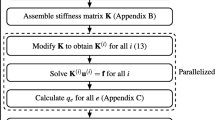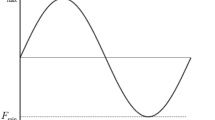Abstract
The design philosophy of fail-safe structures was first proposed in the aerospace industry to provide redundant load paths as back-ups when local damage happens. Most fail-safe topology optimization methods paid more attention to minimizing compliance of the worst failure case. However, the stress concentration due to local failure may lead to secondary damage and further destroy the structure. In the current work, the von Mises stress of damaged structures is considered as the optimization objective, to alleviate the stress concentration caused by possible local failures. Two sorts of topology optimization objectives are investigated: (1) the worst-case formulation; (2) the mean-performance formulation. To avoid the ‘singularity’ problem, the stress is penalized through the RAMP interpolation scheme. The Kreisselmeier-Steinhauser (KS) aggregation function is used to approximate the global stress level. Concerning the highly nonlinear stress behavior, the Method of Moving Asymptotes (MMA) solver is adopted. Finally, the benefits and drawbacks of these two objective functions are systematically compared and discussed through several numerical examples.


















Similar content being viewed by others
References
Arora J, Govil A, Haskell D (1980) Optimal design of large structures for damage tolerance. AIAA J 18:563–570
Bourdin B (2001) Filters in topology optimization. Int J Numer Methods Eng 50(9):2143–2158
Bruggi M (2008) On an alternative approach to stress constraints relaxation in topology optimization. Struct Multidisc Optim 36(2):125–141
Bendsøe MP, Kikuchi N (1988) Generating optimal topologies in structural design using a homogenization method. Comput Methods Appl Mech Eng 71(2):197–224
Bendsøe MP, Sigmund O (2004) Topology Optimization—Theory. Methods and Applications. Springer, Berlin
Cid C, Baldomir A, Hernández S (2020) Probability-damage approach for fail-safe design optimization (PDFSO). Struct Multidisc Optim 62(6):3149–3163
Cheng G, Guo X (1997) ε-relaxed approach in structural topology optimization. Struct Optim 13(4):258–266
Chen Z, Long K, Wen P, Nouman S (2020) Fatigue-resistance topology optimization of continuum structure by penalizing the cumulative fatigue damage. Adv Eng Softw 150:102924
Duysinx P, Bendsøe MP (1998) Topology optimization of continuum structures with local stress constraints. Int J Numer Meth Eng 43(8):1453–1478
Feng Y, Moses F (1986) Optimum design, redundancy and reliability of structural systems. Comput Struct 24(2):239–251
Fu Y, Rolfe B, Chiu LN, Wang Y, Huang X, Ghabraie K (2019) Design and experimental validation of self-supporting topologies for additive manufacturing. Virtual Phys Prototy 14(4):382–394
Goranson U (1993) Damage tolerance-facts and fiction. 17th Symposium of the International Committee on Aeronautical Fatigue. Stockholm, Sweden
Guest J, Prevost J, Belytschko T (2004) Achieving minimum length scale in topology optimization using nodal design variables and projection functions. Int J Numer Meth Eng 61(2):238–254
Guo X, Zhang W, Zhong W (2014) Doing topology optimization explicitly and geometrically—a new moving morphable components based framework. J Appl Mech 81(8):081009
Huang X, Xie Y (2007) Convergent and mesh-independent solutions for the bi-directional evolutionary structural optimization method. Finite Elem Anal Des 43(14):1039–1049
Jansen M, Lombaert G, Schevenels M, Sigmund O (2014) Topology optimization of fail-safe structures using a simplified local damage model. Struct Multidisc Optim 49(4):657–666
Kranz M, Lüdeker JK, Kriegesmann B (2021) An empirical study on stress-based fail-safe topology optimization and multiple load path design. Struct Multidisc Optim 64:2113–2134
Kreisselmeier G, Steinhauser R (1980) Systematic control design by optimizing a vector performance index. In: Internationa federation of active controls symposium on computer-aided design of control systems, Zurich
Kiyono CY, Vatanabe SL, Silva ECN, Reddy JN (2016) A new multi-p-norm formulation approach for stress-based topology optimization design. Compos Struct 156:10–19
Lee K, Ahn K, Yoo J (2016) A novel P-norm correction method for lightweight topology optimization under maximum stress constraints. Comput Struct 171:18–30
Lüdeker JK, Kriegesmann B (2019) Fail-safe optimization of beam structures. J Comput Des Eng 6(3):260–268
Lei X, Liu C, Du Z, Zhang W, Guo X (2019) Machine learning-driven real-time topology optimization under moving morphable component-based framework. J Appl Mech 86(1):011004
Luo Y, Wang M, Kang Z (2013) An enhanced aggregation method for topology optimization with local stress constraints. Comput Methods Appl Mech Eng 254:31–41
Liu J, Wen G, Qing Q, Li F, Xie Y (2018) Robust topology optimization for continuum structures with random loads. Eng Comput 35(2):710–732
Melosh RJ, Johnson JR, Luik R (1968) Structural survivability analysis. Second Conference on Matrix Methods in Structural-Mechanics. WPAFB Ohio
Martínez-Frutos J, Ortigosa R (2021) Risk-averse approach for topology optimization of fail-safe structures using the level-set method. Comput Mech 68:1039
Meng L, Zhang W, Quan D, Shi G, Tang L, Hou Y, Gao T (2019) From topology optimization design to additive manufacturing: Today’s success and tomorrow’s roadmap. Arch Comput Method E 1–26.
París J, Navarrina F, Colominas I, Casteleiro M (2010) Block aggregation of stress constraints in topology optimization of structures. Adv Eng Softw 41(3):433–441
Peng X, Sui Y (2018) ICM method for fail-safe topology optimization of continuum structures. Chin J Theor App Mech 50(3):611–621
Rong J, Xiao T, Yu L, Rong X, Xie Y (2016) Continuum structural topological optimizations with stress constraints based on an active constraint technique. Int J Numer Meth Eng 108(4):326–360
Sigmund O (1994) Design of material structures using topology optimization. Ph.D. Thesis, Department of Solid Mechanics, Technical University of Denmark
Sigmund O (2001) A 99 line topology optimization code written in Matlab. Struct Multidisc Optim 21(2):120–127
Stolpe M (2019) Fail-safe truss topology optimization. Struct Multidisc Optim 60(4):1605–1618
Svanberg K (1987) The method of moving asymptotes – A new method for structural optimization. Int J Numer Meth Eng 24:359–373
Sun P, Arora JS, Haug EJ (1976) Fail-safe optimal design of structure. Eng Optimiz 2(1):43–53
Sved G, Ginos Z (1968) Structural optimization under multiple loading. Int J Mech Sci 10(10):803–805
Stolpe M, Svanberg K (2001) An alternative interpolation scheme for minimum compliance topology optimization. Struct Multidisc Optim 22(2):116–124
Sethian JA, Wiegmann A (2000) Structural boundary design via level set and immersed interface methods. J Comput Phys 163(2):489–528
Verbart (2015) Topology optimization with stress constraints. PhD thesis. Delft University of Technology
Wang F, Lazarov B, Sigmund O (2011) On projection methods, convergence and robust formulations in topology optimization. Struct Multidisc Optim 43:767–784
Wang H, Liu J, Wen G (2020a) An efficient evolutionary structural optimization method for multi-resolution designs. Struct Multidisc Optim 62(2):787–803
Wang H, Liu J, Wen G, Xie Y (2020b) The robust fail-safe topological designs based on the von Mises stress. Finite Elem Anal Des 171:103376
Wang M, Wang X, Guo D (2003) A level set method for structural topology optimization. Comput Methods Appl Mech Eng 192(1):227–246
Wei P, Wang M, Xing X (2010) A study on XFEM in continuum structural optimization using a level set model. Comput Aided Design 42(8):708–719
Xu B, Han Y, Zhao L (2020) Bi-directional evolutionary topology optimization of geometrically nonlinear continuum structures with stress constraints. Appl Math Model 80:771–791
Xie Y, Steven GP (1993) A simple evolutionary procedure for structural optimization. Comput Struct 49(5):885–896
Xia L, Zhang L, Xia Q, Shi T (2018) Stress-based topology optimization using bi-directional evolutionary structural optimization method. Comput Methods Appl Mech Eng 333:356–370
Yang D, Liu H, Zhang W, Li S (2018) Stress-constrained topology optimization based on maximum stress measures. Comput Struct 198:23–39
Zhou M, Fleury R (2016) Fail-Safe Topology Optimization. Struct Multidisc Optim 54(5):1225–1243
Zhang W, Li D, Yuan J, Song J, Guo X (2017) A new three-dimensional topology optimization method based on moving morphable components (MMCs). Comput Mech 59(4):647–665
Acknowledgements
This work was supported by the National Natural Science Foundation of China (No.11672104, 11902085, 12172095), the Key Program of National Natural Science Foundation of China (No. 11832009), and the Chair Professor of Lotus Scholars Program in Hunan province (No. XJT2015408). In addition, we would like to express our sincere thanks to professor Krister Svanberg for providing the implementation of MMA method.
Author information
Authors and Affiliations
Corresponding author
Ethics declarations
Conflict of interest
The authors declare that they have no conflict of interest.
Replication of results
The presented approach is a part of a new project such that we can not share it publicly. But the basic code of this work is available from the corresponding author on reasonable request.
Additional information
Responsible Editor: Jianbin Du
Publisher's Note
Springer Nature remains neutral with regard to jurisdictional claims in published maps and institutional affiliations.
Rights and permissions
About this article
Cite this article
Wang, H., Liu, J. & Wen, G. A study on fail-safe topological design of continuum structures with stress concentration alleviation. Struct Multidisc Optim 65, 174 (2022). https://doi.org/10.1007/s00158-022-03259-0
Received:
Revised:
Accepted:
Published:
DOI: https://doi.org/10.1007/s00158-022-03259-0




